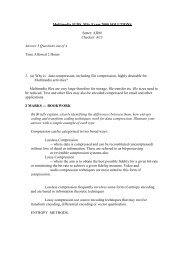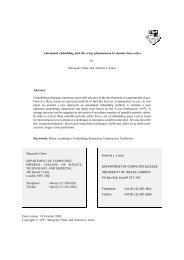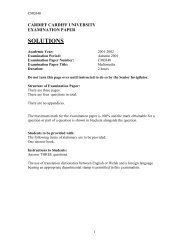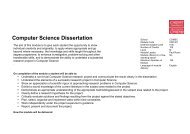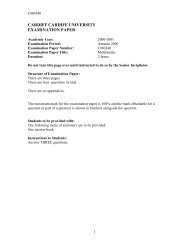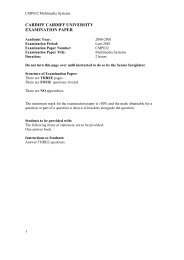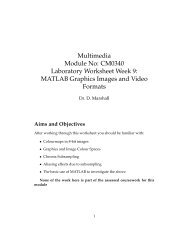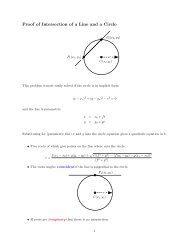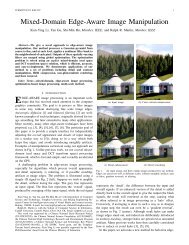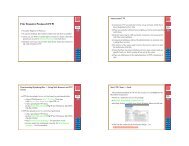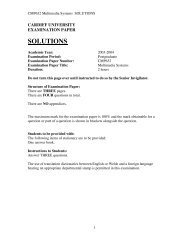Download - Cardiff School of Computer Science & Informatics
Download - Cardiff School of Computer Science & Informatics
Download - Cardiff School of Computer Science & Informatics
You also want an ePaper? Increase the reach of your titles
YUMPU automatically turns print PDFs into web optimized ePapers that Google loves.
Visual Computing<br />
Visual computing covers computer vision,<br />
computer graphics, geometric computing<br />
and both image and video processing.<br />
There are many applications in this area,<br />
and much <strong>of</strong> our work is inter-disciplinary.<br />
The group has had recent collaborations<br />
with the <strong>School</strong>s <strong>of</strong> Engineering, Psychology,<br />
Dentistry, Optometry and Earth <strong>Science</strong>s.<br />
The group has attracted top quality<br />
international researchers as staff, and<br />
recent collaborations include: University <strong>of</strong><br />
Cambridge, University <strong>of</strong> Oxford, Harvard<br />
University, University <strong>of</strong> Southern<br />
California, Tsinghua University, Peking<br />
University, Seoul National University, Korea<br />
University, Aachen University. Industrial<br />
links exist with Delcam, Royal Mint,<br />
Renishaw, Unigraphics, Airbus, General<br />
Dynamics, and QinetiQ.<br />
Recent graduates from<br />
the group have gone<br />
on to positions in<br />
industry (e.g. EADS),<br />
government positions<br />
(e.g. Office for<br />
National Statistics)<br />
and university faculty<br />
positions.<br />
The group is part <strong>of</strong> RIVIC (Research<br />
Institute <strong>of</strong> Visual Computing), the only<br />
pan Wales computer science consortium,<br />
which has been funded by a £5m grant<br />
from the Welsh government.<br />
Some examples <strong>of</strong> major research themes<br />
covered by the group are:<br />
◗ Reverse engineering <strong>of</strong> CAD models,<br />
i.e. regenerating CAD models from<br />
scan data. One <strong>of</strong> the group's papers<br />
on this topic has been cited more<br />
than 1000 times.<br />
◗ 3D triangle mesh processing, in which<br />
algorithms have been developed for<br />
manipulating and improving the quality<br />
<strong>of</strong> meshes by noise filtering,<br />
segmentation, morphing, texture<br />
transfer, parameterization,<br />
watermarking and remeshing.<br />
◗ Face analysis, in which both static and<br />
video sequences <strong>of</strong> both 2D and 3D<br />
data are analysed to develop biometric<br />
(recognition) systems and also build<br />
perceptual models and stimuli that<br />
have then been applied within<br />
psychological experiments.<br />
◗ The group is working on controlling,<br />
modelling, simulating and identifying<br />
quantum systems for applications in<br />
nano-electronics, photonics, quantum<br />
computing, quantum networks, and<br />
medical applications.<br />
◗ The group is participating in the INSIST<br />
EU Marie Curie International Training<br />
Network involving. Its objective is the<br />
development <strong>of</strong> the next generation<br />
design/simulation methods based on<br />
isogeometric analysis.<br />
Examples <strong>of</strong> active specific research topics<br />
within the group are:<br />
◗ Human motion analysis<br />
◗ Image and 3D shape retrieval<br />
◗ Point-based modelling<br />
◗ Reverse engineering <strong>of</strong> solid shape<br />
◗ Solid, curve and surface modelling<br />
◗ Characterisations and analysis <strong>of</strong> shape<br />
◗ finite element meshing<br />
◗ visualisation and analysis <strong>of</strong> sports data<br />
◗ image registration<br />
◗ non-photorealistic rendering<br />
◗ cellular automata<br />
◗ 3D model segmentation<br />
◗ data/information fusion<br />
◗ Quantum engineering<br />
◗ Human perception and vision<br />
space rendering<br />
◗ Optimal route and reaction design for<br />
chemical synthesis (member <strong>of</strong> the<br />
Dial-A-Molecule EPSRC network).<br />
Name:<br />
Jonathan Quinn<br />
Jonathan recently completed his PhD<br />
on ‘Low-Discrepancy Sampling <strong>of</strong> 2D<br />
Manifolds for Applications in Visual<br />
Computing’. He now works within the<br />
One Wales Research Institute for Visual<br />
Computing.<br />
“During my PhD I investigated the<br />
problem <strong>of</strong> sampling, within the field <strong>of</strong><br />
Visual Computing. Sampling is a hugely<br />
important problem in <strong>Computer</strong><br />
<strong>Science</strong>, but more specifically, I<br />
considered how to optimally sample 3D<br />
models for rendering and mathematical<br />
simulations. High quality sampling<br />
allows for the simplification <strong>of</strong> complex<br />
models, whilst preserving important<br />
features. Simplified models speed up<br />
rendering, transmission, and search<br />
algorithms, and reduce storage costs.<br />
Our solution involved the development<br />
<strong>of</strong> algorithms to reduce the<br />
dimensionality <strong>of</strong> the 3D models, thus<br />
reducing the difficulty <strong>of</strong> the sampling<br />
problem.”<br />
26<br />
www.cardiff.ac.uk/computerscience




